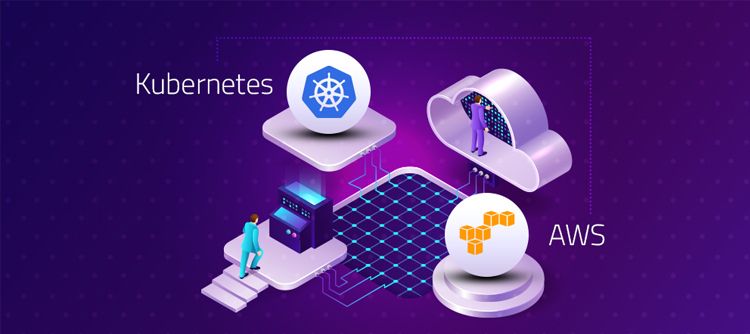
Subscribe to our Blog
We're committed to your privacy. SayOne uses the information you provide to us to contact you about our relevant content, products, and services. check out our privacy policy.

Akhil SundarAugust 5, 20227 min read

Generating table of contents...
Kubernetes is a widely used orchestration platform. Kubernetes is a popular containerization service and has encouraged the tech community to innovate. Further, it has also caused a disruption in cloud-native space where Kubernetes innovators are coming up with the newest path breaking ideas.
Today, containers are being used mostly by companies that have over a thousand employees and running their data centers. These firms also have another point in common, this being the fact that they all use Kubernetes in production.
Kubernetes, a free-source software, allows you to deploy and scale containerized applications. Kubernetes helps to organize and run containers on clusters of instances computed using Amazon EC2. Additional processes for deployment, maintenance, and scaling are also present. Thus, by using Kubernetes, it is possible to run any containerized application, on-premises and within the cloud, using the same toolset.
AWS infrastructure makes it easy to run Kubernetes in the cloud with virtual machine infrastructure that is scalable and highly available. There are also community-backed service integrations present. Moreover, Amazon Elastic Kubernetes Service (EKS), a certified Kubernetes conformant to run Kubernetes on both AWS and on-premises and a managed service, is also used.
Read our blog, “Microservices Architecture – Getting started with Amazon ECS”.
Kubernetes, an open-source project, can be used to run containerized applications anywhere without any changes in the operational tooling. Kubernetes is maintained by a large community of volunteers and, therefore, is continuously improving. Also, many different and independent open-source projects and vendors build and maintain innovative Kubernetes-compatible software that you can also use. This can help to extend your application architecture as well as strengthen it.
You can configure as well as manage all deployments by yourself when you decide to develop AWS on Kubernetes. This allows complete control and flexibility. To manage the implementation, you can use the AWS services that are available.
Kubernetes Operations, otherwise called Kops, is an open-source project that is used to create Kubernetes clusters easily and swiftly. It is thought to be the “kubectl” way of setting up clusters. Kops works to deploy highly available Kubernetes clusters on both AWS (it officially supports kOps) and Google (GCP) clouds.
EKS expands to Elastic Kubernetes Service and it is a managed service on offer by AWS. EKS provides a managed control plane for cluster deployment by taking the help of automatically provisioned instances.
This is an enterprise computing platform that allows you to deploy Kubernetes clusters in the cloud and on your premises. These clusters can be unified and operated to ensure consistency, manages the workload, and offers enterprise-grade security.
Download the ebook for FREE: "How to choose the best microservices vendor and trim the costs".
Heptio supports CloudFormation and uses kubeadm to deploy Kubernetes on AWS. Heptio is most suited for users who are already familiar with the CloudFormation AWS orchestration tool. Heptio supports multi-AZ.
This is a group of tools that has production-ready defaults capable of making an enterprise-level Kubernetes cluster. The objective is to help organizations to set up and manage their Kubernetes infrastructure as well as the clusters.
The kubeadm project works to form an easy cluster on AWS using Terraform. It is a basic tool for tests and proofs-of-concept. kubeadm does not support multi-AZ.
Other tools that can be used include OpenShift, Stackpoint, Tack (Pre-Terraform, Terraform, Post Terraform), and Tectonic.
Though AWS is the most preferred solution for running cloud-native applications, it is not an easy job to set up and run Kubernetes on it. However, there are many advantages of running Kubernetes on AWS. The best reason is that you can take advantage of the many available services. Other reasons are:
Kubernetes works by scheduling containers to run on a set of compute instances with support from the available compute resources. This helps to meet the resource needs of every container. Containers are run in logical groupings (pods). One or many containers can be scaled and run together as a pod.
Read our blog : Troubleshooting Kubernetes- Using the Shift-left approach
Kubernetes control plane software controls the running of the pods. Its other functions include managing traffic routing and the worker nodes and the pods in the cluster. Kubernetes starts those pods that support the resource requirements of your cluster and they can also automatically restart the pods if they, or the instances they're running on, happen to fail. Each pod has an I.P. address and one DNS name. This is used by Kubernetes to attach the services as well as the external traffic.
This is a managed Kubernetes service that makes it easy for a user to run Kubernetes on AWS as well as on-premises. The user need not strive to put in, operate, or maintain the Kubernetes control plane or nodes.
Amazon EKS helps to automatically manage both the availability and scalability of the Kubernetes control plane nodes that are responsible for scheduling containers, managing the application’s availability, storing cluster data, and some other key tasks.
Read our blog : Kubernetes Health Checks: Some things you need to know
Amazon EKS allows you to run Kubernetes applications on both Amazon EC2 and AWS Fargate. Amazon EKS allows you to take advantage of all the performance, reliability, scale, and availability of AWS infrastructure, plus the integrations with AWS networking and security services that include application load balancers which help load distribution, AWS Identity and Access Management integration providing role-based access control (RBAC), and AWS VPC (Virtual Private Cloud) VPC support for pod networking.
All the existing plugins and toolkits from the Kubernetes community can be used when building applications to run on Amazon EKS. These will be fully compatible with applications running on any Kubernetes environment, whether on-premises data centers/public clouds. This means that any standard Kubernetes application can be migrated to Amazon EKS without any code modification.
Are you looking to reorganize your legacy software? Talk to us today!
At SayOne, we offer independent and stable services that have separate development aspects as well as maintenance advantages. We build microservices especially suited for businesses in different industry verticals. In the longer term, this would allow your organization/business to enjoy a sizeable increase in both growth and efficiency.
Our comprehensive services in microservices development for start-ups, SMBs, and enterprises start with extensive microservices feasibility analysis to provide our clients with the best services. We use powerful frameworks for our custom-built microservices for different organizations. Our APIs are designed to enable fast iteration, easy deployment, and significantly less time to market. In short, our microservices are dexterous and resilient and deliver the security and reliability required for the different functions.

We're committed to your privacy. SayOne uses the information you provide to us to contact you about our relevant content, products, and services. check out our privacy policy.

About Author
Subject Matter Expert

We collaborate with visionary leaders on projects that focus on quality